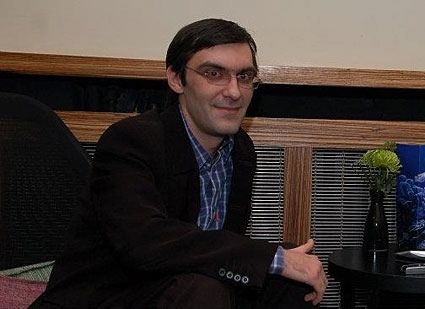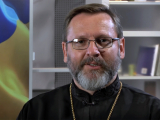Andrey Sheptytsky as a symbol of the Kyiv Church
Saturday, 02 November 2013, 12:33 On November 1, 1944, a prominent Son of our Church – Blessed Servant of God, Metropolitan Andrey Sheptytsky died. Now it is already the 69th year during which the Church painfully, yet with gratitude and respect, commemorates his memory.
-
See also:
- To complete a beatification process of metropolitan Andrey we need to love him, - the Head of the UGCC on Remembrance Day of Andrey Sheptytsky
- A book about a philanthropic and beneficent activity of Andrey Sheptytsky has come out
- A traditional pilgrimage to Prylbychi, the Sheptytskys' family nest, took place
He headed the Church for nearly 44 years. He began at the beginning of the last century, when – it seemed – everything was clear. Exactly ten years prior , his predecessor Metropolitan Sylvester Sembratovych, conducted the Lviv Synod. There the future development of the Greek-Catholic Church was planned and its past was assessed. It seemed that in the next 100 years, nothing would change. The Austro-Hungarian Empire seemed an inviolable cliff. No end seemed in site for the struggles between Ukrainians, and Poles as well as Moscowphiles. After Sembratovych, the elderly Yulian Sas-Kuyilovsky became the Metropolitan. However, he passed away within barely a year.
And here appeared Andrey Sheptytsky. He came from an old noble family which had been Polonized and Latinized. The new Metropolitan immediately created a reaction of surprise among all existing parties, both within the Church as well as in all of Galicia. The young Basilian priest was barely 35 and he was met with distrust. People were afraid that the Church would be Latinized and the clergy would be Polonized.
However, Metropolitan Andrey immediately sets to change church life – both liturgically and socially.
He opens the Greek-Catholic Church in the Russian Empire. He cares about Ukrainian lands under Russian rule. For some reason it is very rarely mentioned that the first -- after many years of persecution after the Brest treaty -- Uniate Church in Kyiv emerged during the time of Sheptytsky. The Church of the Sacred Heart of Christ on 10 Novopavlivska St, was built in 1917 – officially for Galician soldiers of World War I who remained in Kyiv. It was destroyed only in 1935.
Sheptytsky tried to bring the Church closer to all Ukrainians – this was what forced him to work also in the Russian Empire. He included youth from Eastern Ukraine into UGCC. Basically, it was precisely the reason why the Russian Greek-Catholic Church was founded. Of course, the Metropolitan wanted to convert Russia. However, the primary task was to turn the Ukrainian lands back to the religion of the ancestors. Then the Metropolitan establishes the Congregation of Studites – he wants to be closer to the Eastern tradition.
The controversial “conversion” of Sheptytsky to this tradition and the limitation of Latin practices in the Church had, specifically, this goal. And perhaps this was even the main goal. The conversion of the East, the renewal of unity in the only Church was the clear focus of many epistles by the Metropolitan. In order to achieve this, one had to be understandable to the East, turn to the Kyivan tradition, not losing one’s own possessions. The return of the Union to Dnipro was to be the crowning wreath of his attempts. In this, perhaps, lies the biggest, worthy of awe, significance of this colossal figure of our Church. Not in the political dimension. Not in the Eastern Rite. And not even in the saving of the poor, the persecuted and the indigent, -- since this is the responsibility of every Christian. Metropolitan Andrey dreamt of Kyiv, considered the location of the Seat of the Church in Lviv as temporary, -- that the time would come when it also return to its roots. Before him, maybe no Lviv Metropolitan thought in such categories. And how dared one to think so, when even from the time of the late Metropolitan Josaphat Bulhak, the Church on Russian territories was methodically destroyed “so that not even a breadth of it would remain…” In 1917, Sheptytsky even appoints an Exarch for the Greek-Catholics in Greater Ukraine with a residence in Kyiv -- the rev. Mykhaylo Tsehelsky. This figure also has until now been undervalued and almost unknown in our Church.
Sheptytsky assiduously works with congregations. It is during his rule that in the Eastern Rite we have the appearance of the Redemptorist Fathers and even the Benedictine Fathers. True, the latter, have for some reason, even to this day, not really established their roots in Ukraine.
After World War I and the forced separation from his flock, wandering through Russia in exile, the Metropolitan returns to Lviv. In some twenty years the Austro-Hungarian Empire was ruined, and some attempts to renew Ukrainian statehood were drowned in blood by the bolsheviks. Western Ukraine ends up as part of Poland. And even in this situation, Sheptytsky does not give up. He establishes the Lviv Theological Academy which is to become the first university for Catholics of the Eastern Rite in Ukraine, a Theological Scholarly Society, and the Ukrainian Catholic Institute of Church Unity. The latter is named after the renowned Kyiv Uniate Metropolitan Veliamyn Rutskyi. This once more underlines the unity of the view of the Church in Ukraine. He does everything possible in order to renew the Church in the cradle of the Union – on Volyn lands, which for the most part, ended up in Poland. Immediately prior to World War II, he appoints as Exarch for Volyn -- Bishop Mykola Charnetsky who died as a martyr after a long term in the Mordovia camps.
Immediately before World War II he appoints as Exarch for Volyn -- Bishop Mykola Charnetsky who died as a martyr after a long term in the Mordovia camps.
Three years before his death, the Metropolitan in his Easter sermon very directly beseeches all Ukrainians: “With this Paschal Greeting, I wish you the best holyday greetings – you who are listening to me on this night of Christ’s Resurrection -- primarily you, the faithful of the Archeparchy, and you, brothers in the distant Ukraine on the Dnipro. May the Risen Christ who lives among us -- who is and will continue to be among us -- may He bless you, may He cleanse you from all, even the slightest taint of a sin, may He comfort you in all sorrows and may He in during this Pascal time give you at least a bit of the ability to feel the happiness of the Resurrection, the joy of the blessings of life and that hope which Christ left for the apostles and all faithful Christians.”
It is only 61 years after the death of the Servant of God that his dreams became reality – and eventually UGCC does return to Kyiv. Andrey Sheptytsky became for all of us the symbol of the unity and indestructibility of the Church in Ukraine, similarly to the Saint Priest Martyr Josaphat Kuntsevych, who accepted death for the sake of the unity of Christ’s Church, Therefore, it is exactly why we should not forget his words and eventually fulfill the cause, which he bequeathed to us all.
Ihor Lubianov special for UGCC Department of Information

We can imagine what the prayer of the prisoners in the Russian torture centers in the Ukrainian Kharkiv region was like – Head of the UGCC on the 206th day of the war 17 September
A vast cemetery, a mass burial, was found near the city of Izyum, in which more than 400 innocently killed and tortured people have already been...

